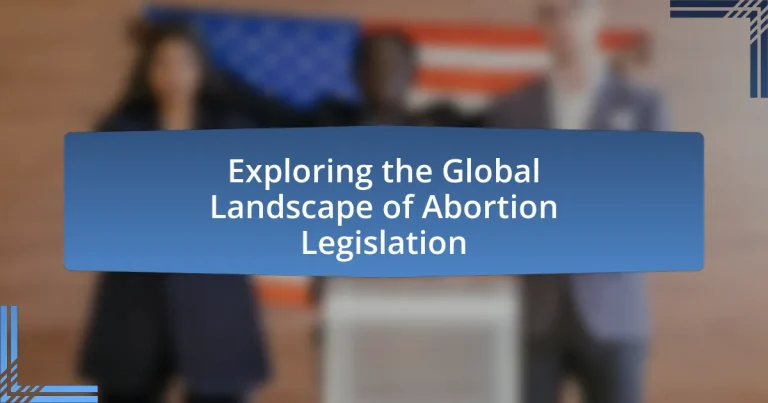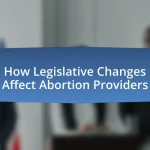The article explores the global landscape of abortion legislation, highlighting the significant variations in laws and access across different countries. It examines the cultural, religious, and political factors that influence these laws, illustrating how they impact women’s health and rights. The piece also discusses historical contexts, current trends, and the implications of both restrictive and liberal abortion laws, emphasizing the role of advocacy and education in shaping public opinion and policy changes. Key challenges faced in accessing safe abortion services are addressed, alongside best practices for improving legislation and promoting reproductive rights.

What is the Global Landscape of Abortion Legislation?
The global landscape of abortion legislation is characterized by a wide range of laws and regulations that vary significantly across different countries. In some nations, such as Canada and many European countries, abortion is legal and accessible, often with few restrictions. Conversely, countries like El Salvador and Nicaragua impose strict bans on abortion, even in cases of rape or when the mother’s life is at risk. According to the World Health Organization, approximately 25 million unsafe abortions occur each year, highlighting the impact of restrictive laws on women’s health. This disparity in legislation reflects cultural, religious, and political influences that shape the legal status of abortion worldwide.
How does abortion legislation vary across different countries?
Abortion legislation varies significantly across different countries, reflecting diverse cultural, religious, and political contexts. For instance, in countries like Canada and the Netherlands, abortion is legal and accessible, often without restrictive conditions, allowing women to make choices about their reproductive health. Conversely, nations such as El Salvador and Nicaragua impose strict bans on abortion, even in cases of rape or health risks, leading to severe legal consequences for women and healthcare providers. According to the World Health Organization, as of 2021, approximately 40% of women of reproductive age live in countries with restrictive abortion laws, highlighting the global disparities in access to safe abortion services.
What are the key factors influencing abortion laws in various regions?
Key factors influencing abortion laws in various regions include cultural beliefs, religious doctrines, political ideologies, and socioeconomic conditions. Cultural beliefs shape societal attitudes towards abortion, often determining its acceptance or rejection. For instance, in many conservative societies, traditional views may lead to restrictive laws. Religious doctrines significantly impact legislation; countries with strong religious influences, such as those in the Middle East, often impose strict abortion laws based on religious texts. Political ideologies also play a crucial role; liberal governments may advocate for reproductive rights, while conservative administrations may seek to limit access. Lastly, socioeconomic conditions, including access to healthcare and education, influence the legal framework surrounding abortion, as regions with higher levels of education and healthcare access tend to have more progressive laws.
How do cultural attitudes shape abortion legislation globally?
Cultural attitudes significantly influence abortion legislation worldwide by determining societal norms and values surrounding reproductive rights. In countries with conservative cultural perspectives, such as many in Latin America and Africa, restrictive abortion laws often reflect religious beliefs and traditional views on family and gender roles. Conversely, nations with progressive cultural attitudes, like those in Western Europe and parts of North America, tend to adopt more liberal abortion laws, emphasizing individual rights and gender equality. For instance, in countries like Sweden and Canada, abortion is largely accessible due to a cultural emphasis on women’s autonomy and health rights. This correlation between cultural attitudes and legislative frameworks illustrates how societal beliefs directly shape the legal landscape of abortion across different regions.
What are the historical contexts of abortion legislation?
Abortion legislation has evolved significantly over time, influenced by cultural, religious, and political factors. In ancient societies, such as those in Greece and Rome, abortion was often accepted and practiced, with little legal restriction. However, during the Middle Ages, the rise of Christianity led to stricter prohibitions against abortion, viewing it as morally wrong.
By the 19th century, many Western countries began to criminalize abortion, with laws reflecting the growing influence of medical professionals who argued for the protection of fetal life. For instance, the 1861 Offences Against the Person Act in the UK made abortion illegal, marking a shift towards more restrictive legislation.
In the 20th century, the feminist movement and changing societal attitudes towards women’s rights prompted a reevaluation of abortion laws. Landmark cases, such as Roe v. Wade in the United States in 1973, established a woman’s legal right to choose, influencing abortion legislation globally.
Today, the historical contexts of abortion legislation continue to shape debates, with varying laws reflecting the complex interplay of ethics, rights, and public health across different cultures and nations.
How have historical events influenced current abortion laws?
Historical events have significantly shaped current abortion laws through landmark rulings, social movements, and legislative changes. For instance, the 1973 U.S. Supreme Court decision in Roe v. Wade established a woman’s legal right to choose abortion, influencing similar legal frameworks in various countries. Additionally, the feminist movements of the 1960s and 1970s advocated for reproductive rights, leading to reforms in many nations. The global response to events such as the legalization of abortion in countries like Canada in 1988 and the backlash against it in places like Poland in 2020 further illustrates how historical contexts continue to impact abortion legislation today.
What role did landmark court cases play in shaping abortion rights?
Landmark court cases have played a crucial role in shaping abortion rights by establishing legal precedents that define the extent of reproductive freedoms. For instance, the 1973 Supreme Court case Roe v. Wade recognized a woman’s constitutional right to privacy, effectively legalizing abortion nationwide and setting a significant legal standard that influenced subsequent cases and legislation. This ruling was based on the interpretation of the Due Process Clause of the Fourteenth Amendment, which the Court found to protect a woman’s right to choose to have an abortion. Additionally, cases like Planned Parenthood v. Casey in 1992 reaffirmed Roe v. Wade while allowing states to impose certain restrictions, further shaping the legal landscape of abortion rights. These landmark decisions have not only impacted U.S. law but have also served as influential references in global discussions about reproductive rights.
What are the current trends in abortion legislation worldwide?
Current trends in abortion legislation worldwide show a significant polarization, with some countries liberalizing access while others are imposing stricter regulations. For instance, in the United States, the overturning of Roe v. Wade in 2022 led to numerous states enacting restrictive laws, resulting in increased barriers to abortion access. Conversely, countries like Argentina and Ireland have recently expanded abortion rights, reflecting a shift towards more progressive policies. According to the Guttmacher Institute, as of 2023, 66 countries have liberalized their abortion laws since 1990, indicating a global trend towards greater access in certain regions, while others face regressive measures.
How are recent movements impacting abortion rights?
Recent movements are significantly impacting abortion rights by advocating for increased access and legal protections. For instance, the Women’s March and various grassroots organizations have mobilized millions to demand reproductive rights, leading to legislative changes in several states and countries. In the United States, the overturning of Roe v. Wade in 2022 spurred a surge in activism, resulting in states like California and New York enacting laws to protect and expand abortion access. Additionally, international movements, such as those in Argentina and Ireland, have successfully influenced policy changes, demonstrating a global trend towards liberalizing abortion laws. These movements are reshaping public discourse and legislative frameworks, emphasizing the importance of reproductive autonomy.
What legislative changes have occurred in the past decade?
In the past decade, numerous legislative changes regarding abortion have occurred globally, reflecting a significant shift in policies. For instance, in 2012, Uruguay legalized abortion up to 12 weeks of pregnancy, marking a progressive step in South America. In 2019, the state of New York enacted the Reproductive Health Act, which expanded access to abortion and removed outdated restrictions. Additionally, in 2020, Argentina legalized abortion, becoming the first major Latin American country to do so, allowing abortions up to 14 weeks. Conversely, several U.S. states, such as Texas in 2021, implemented restrictive laws, including the controversial Senate Bill 8, which effectively banned most abortions after six weeks. These changes illustrate the diverse approaches to abortion legislation, with some regions moving towards greater access while others impose stricter regulations.
How do different legal frameworks approach abortion?
Different legal frameworks approach abortion through varying degrees of restriction and access. In countries like Canada and the Netherlands, abortion is largely accessible and regulated as a healthcare service, reflecting a pro-choice stance. Conversely, nations such as El Salvador and Poland impose strict bans or severe limitations, often criminalizing the procedure, which indicates a pro-life perspective. According to the World Health Organization, approximately 25 million unsafe abortions occur annually, highlighting the impact of restrictive laws on women’s health and safety. This disparity in legal frameworks illustrates the broader global debate on reproductive rights and the implications of legislation on women’s autonomy.
What are the implications of restrictive versus liberal abortion laws?
Restrictive abortion laws typically lead to increased rates of unsafe abortions and maternal mortality, while liberal abortion laws generally result in safer procedures and better health outcomes for women. For instance, a study published in The Lancet found that countries with highly restrictive abortion laws have significantly higher rates of unsafe abortions, contributing to an estimated 47,000 maternal deaths annually. Conversely, nations with liberal laws, such as those in Scandinavia, report lower maternal mortality rates and better overall reproductive health outcomes. This evidence illustrates the direct correlation between the legal framework surrounding abortion and the health and safety of women.
How do restrictive laws affect women’s health and rights?
Restrictive laws significantly undermine women’s health and rights by limiting access to essential reproductive healthcare services, including safe abortion. These laws often lead to increased rates of unsafe abortions, which the World Health Organization estimates result in approximately 47,000 deaths annually worldwide. Furthermore, restrictive legislation can exacerbate mental health issues among women by imposing severe penalties for seeking care, thereby creating a climate of fear and stigma. Studies indicate that countries with more liberal abortion laws tend to have better health outcomes for women, highlighting the direct correlation between legal frameworks and women’s health and rights.
What benefits do liberal laws provide to society?
Liberal laws provide significant benefits to society by promoting individual freedoms, enhancing social equality, and fostering public health. These laws often lead to greater access to reproductive rights, including safe and legal abortion services, which can reduce maternal mortality rates. For instance, countries with liberal abortion laws, such as Canada and the Netherlands, report lower rates of unsafe abortions compared to those with restrictive laws, demonstrating a direct correlation between legal access and health outcomes. Additionally, liberal laws contribute to the empowerment of marginalized groups, ensuring that all individuals have the right to make informed choices about their bodies and lives, thereby promoting overall societal well-being.
What are the challenges faced in the global landscape of abortion legislation?
The challenges faced in the global landscape of abortion legislation include varying legal frameworks, cultural opposition, and access to healthcare services. Different countries have distinct laws regarding abortion, ranging from complete bans to unrestricted access, which creates inconsistencies and confusion for individuals seeking services. Cultural and religious beliefs often influence public opinion and political decisions, leading to resistance against liberalizing abortion laws. Additionally, access to safe abortion services is hindered by logistical barriers, such as lack of trained healthcare providers and inadequate facilities, particularly in low-income regions. According to the World Health Organization, unsafe abortions contribute significantly to maternal mortality, highlighting the urgent need for comprehensive legislation and access to safe services.
How do political climates affect abortion rights?
Political climates significantly influence abortion rights by shaping legislation, public opinion, and access to services. In countries with conservative political environments, restrictive laws often emerge, limiting access to abortion and imposing stringent regulations. For instance, in the United States, the overturning of Roe v. Wade in 2022 by a conservative Supreme Court led to numerous states enacting laws that severely restrict or ban abortion altogether. Conversely, progressive political climates tend to promote reproductive rights, as seen in countries like Canada, where abortion is legal and accessible, reflecting a commitment to women’s health and autonomy. This correlation between political ideology and abortion rights is evident in various global contexts, where shifts in government can lead to rapid changes in legislation and access.
What barriers exist for women seeking abortions in restrictive countries?
Women seeking abortions in restrictive countries face significant barriers, including legal restrictions, social stigma, and limited access to healthcare services. Legal restrictions often include stringent laws that either prohibit abortion entirely or allow it only under specific circumstances, such as risk to the mother’s life or cases of rape, which can vary widely by country. For instance, in countries like El Salvador and Nicaragua, abortion is criminalized without exceptions, leading to severe legal consequences for women and healthcare providers.
Social stigma surrounding abortion can further deter women from seeking necessary care, as cultural and religious beliefs often label abortion as morally unacceptable. This stigma can result in isolation and fear of judgment, making women less likely to seek help. Additionally, limited access to healthcare services, particularly in rural areas, can hinder women’s ability to obtain safe and legal abortions. In many restrictive countries, healthcare facilities may lack the resources or trained personnel to provide abortion services, forcing women to resort to unsafe methods.
Statistics indicate that in regions with restrictive abortion laws, such as sub-Saharan Africa and parts of Latin America, unsafe abortions contribute significantly to maternal mortality rates, highlighting the dire consequences of these barriers.
What best practices can be adopted for improving abortion legislation?
To improve abortion legislation, best practices include ensuring access to safe and legal abortion services, providing comprehensive sex education, and implementing supportive healthcare policies. Access to safe and legal abortion services is crucial, as studies show that countries with restrictive laws often have higher rates of unsafe abortions, leading to increased maternal mortality. Comprehensive sex education equips individuals with knowledge about reproductive health, which can reduce unintended pregnancies and the need for abortion. Supportive healthcare policies, such as integrating abortion services into primary healthcare, can enhance accessibility and reduce stigma, ultimately leading to better health outcomes for women.
How can advocacy groups effectively influence policy changes?
Advocacy groups can effectively influence policy changes by employing strategic communication, grassroots mobilization, and coalition-building. Strategic communication involves crafting clear, compelling messages that resonate with policymakers and the public, thereby raising awareness about specific issues, such as abortion legislation. Grassroots mobilization engages community members to participate in campaigns, demonstrating public support for policy changes; for instance, the Women’s March in 2017 mobilized millions to advocate for reproductive rights. Coalition-building allows advocacy groups to unite with other organizations, amplifying their voices and resources, as seen in the collaboration of various reproductive health organizations to challenge restrictive abortion laws. These methods have been proven effective in shaping public opinion and influencing legislative outcomes.
What role does education play in shaping public opinion on abortion?
Education significantly influences public opinion on abortion by providing individuals with knowledge about reproductive health, rights, and the implications of abortion. Research indicates that higher levels of education correlate with more progressive views on abortion, as educated individuals are more likely to understand the complexities surrounding the issue, including medical, ethical, and social dimensions. For instance, a study published in the Journal of Health and Social Behavior found that college-educated individuals are more supportive of abortion rights compared to those with lower educational attainment, highlighting the role of education in fostering informed perspectives.


